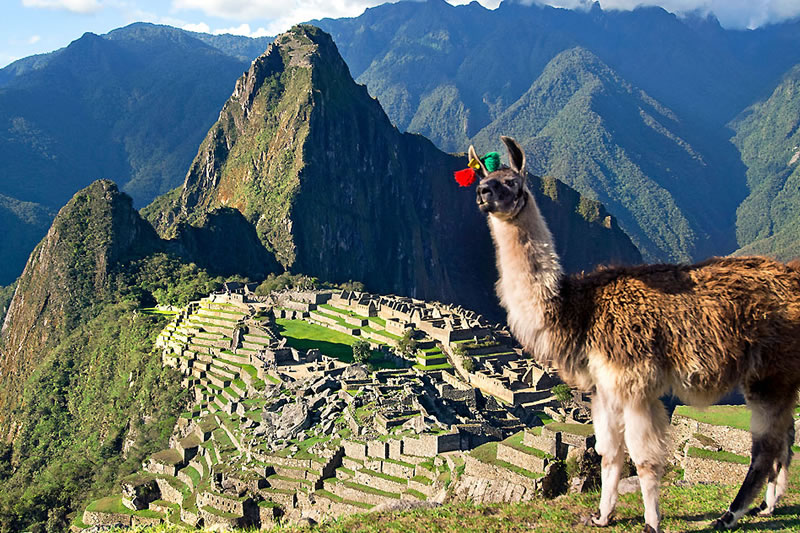Camelids in Machu Picchu
The ancient inhabitants of the Andes, you have left us numerous examples of how valuable were these animals to the Inca Empire, first as food, also they obtained from them (wool), the raw material for clothing and other textiles besides use as pack animals. Sumbay caves in Arequipa, contain traces of thousands of years, showing how the camelids were hunted, wandering in herds across the highlands.
Innate inhabitants of the Andean plains, the Andean camelids (South American) animals are perfectly adapted to their environment. It is known that the alpaca (Lama pacos) and llama (Lama glama), have been domesticated by the Andean man since over ten thousand years ago, to be used as beasts of burden; while two others, the vicuna (Vicugna vicugna) and the guanaco (Lama guanicoe), his skin was used due to the high quality of its wool.

Flame, picturesque camel in Machu Picchu
The Andean camels have evolved to digest hard pastures of the highlands, 25% more efficiently than sheep. This is because their way of feeding, cutting and not pulling the stems, causing minor damage to the plant, avoiding the degradation of grasslands. Their hooves are equipped with padded allowing them to walk softly, avoiding erosion of their herding areas, unlike cattle and sheep.
The Andean camels have evolved to digest hard pastures of the highlands, 25% more efficiently than sheep. This is because their way of feeding, cutting and not pulling the stems, causing minor damage to the plant, avoiding the degradation of grasslands. Their hooves are equipped with pads, allowing them to walk softly, avoiding erosion of their herding areas, unlike cattle and sheep. Adapted to living in the Andes, the variety of living environments, without much competition between species; while the vicuna prefer the highest and arid areas where other animals would be impossible to live, others prefer lower altitudes.
The valleys of Machu Picchu even let you watch llameros with huge herds, passing the valleys to exchange their goods with others that need it. It is almost certain that food and luxury items required for worship, conducted in Machu Picchu, were transported by llama caravans brought from the farthest reaches of the empire.
The hunting of these scary animals was prohibited in the Empire of the Incas, so a technique called chaccu (herding) was used through this, hundreds of men and women held hands to form a human fence around large vicunas and then lead them to fenced places where they were shorn. Practice still current in places like Pampa Galeras and the heights of Arequipa.
Without the use of the llama and the alpaca it has been impossible trade between the valleys and high-altitude areas, especially if you take into account the reciprocity and complementarity as the basis of this civilization. So the trade (based on the exchange) had heavy traffic demand of products by the vast network of roads, covered by major llameros.
Alpaca (Lama pacos) very varied in color from stained blank, to pure white. Males can weigh up to 60 kg, while females do not exceed 55 kg; they produce excellent quality wool with various colorations, fine wool fibers come in two varieties, the Huarcaya, and Suri, being the latter slightly more thin and silky.
Llama (Lama glama) is the largest among the Andean camelid species, adult males reach 155 kg, while females slightly exceed 100 kg. There are two distinct races the called ccara, q’ara or peeled, sparse hair; and the known as ch’aku, similar to the alpaca, with long fibers and media finesse.
Vicuña (Vicugna vicugna) is the smallest species of this group. Males weigh 36 kg, while females, hardly exceed 33 kg. They distributed in groups of solitary males and several females in polygamous families. They are usually brown cinnamon in the back and sides. One feature that differentiates them is the white tuft or fleece that present in his chest.
Guanaco (Lama guanicoe) reddish brown to light brown, with yellowish tones. White on the chest, belly and inner legs sector and paws. Gray or black head, lips and ears with a white border. Make considerable migrations when food is scarce. They weigh about 120 kg.
By Ticket Machu Picchu – Last Update, 27-11-2015
